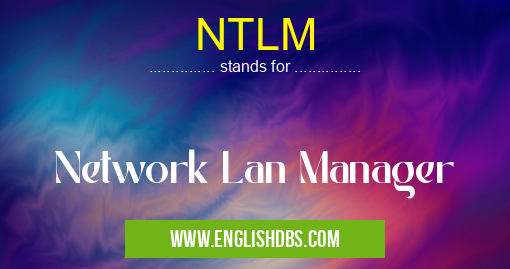What does NTLM mean in NETWORKING
Network LAN Manager (NTLM) is a security protocol developed by Microsoft and IBM to secure the communications between two computers, or machines. It provides authentication, integrity and confidentiality of messages exchanged between machines. The NTLM protocol makes use of credentials such as passwords and digital signatures to establish trust between the two machines. With NTLM, messages are encrypted using message authentication codes (MACs), which ensures that only authorized users can access the data being transmitted. In addition, NTLM also prevents tampering or other malicious activities on the network by providing protection against man-in-the-middle attacks. By implementing NTLM protocols within an organization, businesses can ensure that their data is well protected from unauthorized access and malicious actors on their networks.

NTLM meaning in Networking in Computing
NTLM mostly used in an acronym Networking in Category Computing that means Network Lan Manager
Shorthand: NTLM,
Full Form: Network Lan Manager
For more information of "Network Lan Manager", see the section below.
» Computing » Networking
Essential Questions and Answers on Network Lan Manager in "COMPUTING»NETWORKING"
What is NTLM?
Network Lan Manager (NTLM) is a Microsoft security protocol that provides authentication, integrity and confidentiality to users on a network. It works by encrypting the credentials of a user when they try to authenticate to the network. NTLM is used in networks where Windows computers are present, and is available for other operating systems as well.
How does NTLM authentication work?
NTLM authentication consists of three messages that are sent between the user's client computer and the server. The first message is the challenge message sent from the server to the client which contains a random number known as a “nonce†that must be solved by the client in order to prove its identity. The second message is sent from the client back to the server containing an encrypted version of the nonce, proving that it has been solved correctly. The third message from server to client contains an encrypted session key with which future communication between them can be encrypted.
Why do we need NTLM?
In today's world, there are many networks and devices that contain sensitive information which needs to be protected from unauthorized access by implementing effective security measures. NTLM provides strong authentication capabilities for Windows computer systems and networks, making it possible for users to easily establish secure connections without compromising their privacy or data integrity. By using this protocol, organizations can ensure that only authenticated users are able to connect their devices and access sensitive information in their networks.
How secure is NTLM?
When properly implemented, NTLM offers strong security features such as password hashing algorithms, encryption techniques, and time-based access control measures which make it difficult for attackers to steal or modify data stored in your systems. Additionally, once an attacker successfully authenticates via this protocol they will typically only be able to view information they have been authorized to view due to its granular authorization rulesets. As such, if all recommendations regarding implementation best practices are followed, then one can reasonably assume that any system protected by this protocol should remain secure against unauthorized access attempts.
Is NTLM still used today?
Yes, despite being an older Microsoft technology introduced in 1993 as part of Windows NT 3.1; NTLM remains widely used today in organizations utilizing Windows Active Directory services - due largely in part because of its effectiveness at providing reliable protection against malicious activity on corporate networks without requiring continuous user interaction during authentication processes.. That said however; newer more secure technologies such as Kerberos and OAuth 2 are slowly replacing this older standard due primarily because organizations recognize the need for better internal network security protections in order keep up with changing threats posed by malicious actors on public internet-connected networks.
What environments benefit most from using NTLM?
Generally speaking; environments where legacy applications predominantly utilize Windows services stand benefit most from leveraging this technology since they require somewhat uniform system configurations across all users allowing administers better control over access permissions within those environments while still maintaining some level of autonomy within their system architectures.
Are there any disadvantages associated with using this protocol?
Unfortunately yes; despite offering strong protections; researchers have identified several serious vulnerabilities with this technology - particularly regarding its support for passwords stored using reversible encryption techniques which allow attackers easy access into environments protected under this protocol if proper password management protocols were not enforced.
What industry standards should I follow when configuring my environment with NTLM?
Generally speaking you should take special care when configuring your environment with regards two aspects namely policies governing how passwords are managed under this protocol (e.g., enforcing 8+ character alphanumeric requirements) as well as how sessions timeout (e.g., if no direct user input occurs within x period of time terminate session).
Final Words:
In summary, Network LAN Manager (NTLM) is a security protocol developed by Microsoft and IBM to protect communication between two computers through authentication, integrity and confidentiality of messages exchanged between them. Organizations can benefit from this protocol as it helps to prevent data leakage and other malicious activities on their networks. With NTLM in place, businesses can be sure that their data remains safe and secure from external threats.
